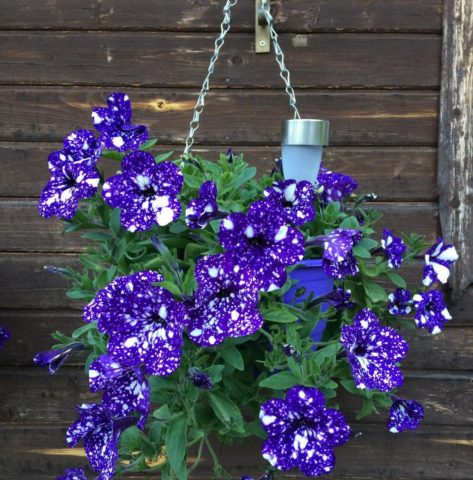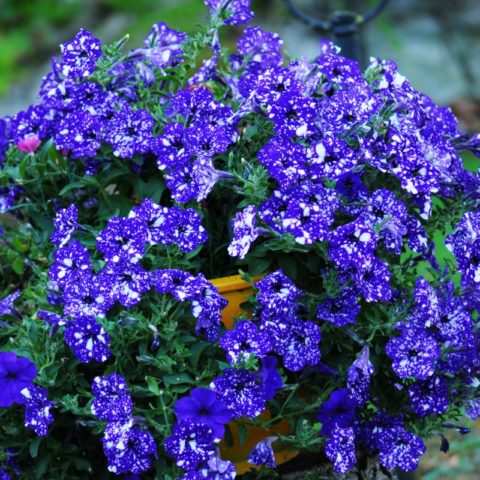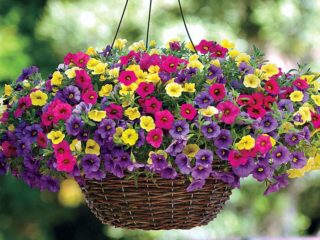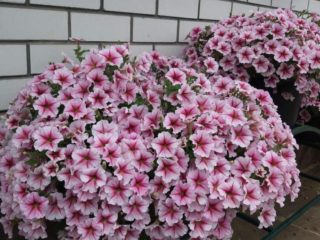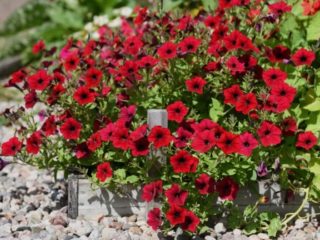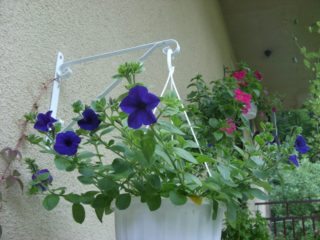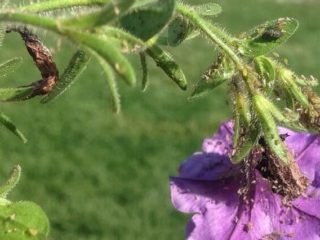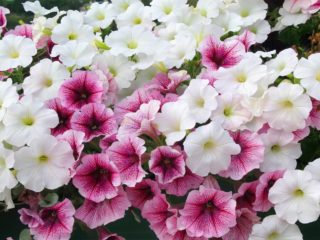Content
- 1 History of selection
- 2 Description of the variety and characteristics
- 3 Advantages and disadvantages of the variety
- 4 Reproduction of petunia Starry sky
- 5 Growing Petunia Starry Sky
- 6 Flower care
- 7 Pests and diseases
- 8 Application in landscape design
- 9 Conclusion
- 10 Reviews with photos about the petunia variety Starry Sky
Petunia Starry Sky is a hybrid plant variety artificially bred by breeders. The culture owes its name to its unusual coloring. Petunia is dark purple in color with small white speckles that resemble bright stars in the night sky. The hybrid is undemanding in care, and thanks to its color it always looks impressive.
History of selection
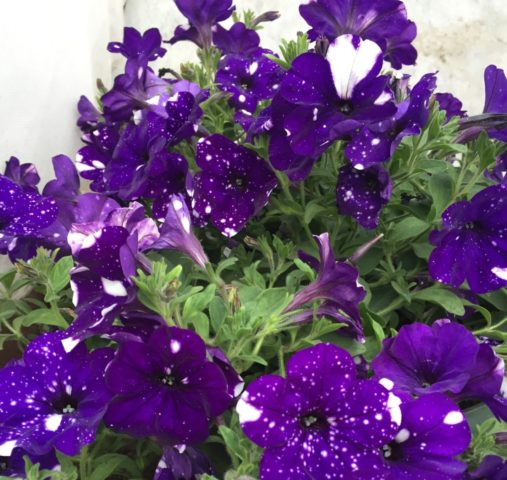
The Starry Sky variety differs from others in its unusual appearance.
In its natural environment, petunia lives in the tropical regions of Uruguay, Paraguay, Argentina, Brazil, Bolivia, as well as North and South America. Thanks to the efforts of breeders, a large number of varieties of the crop are known today. This flower was first heard of in the 18th century. Since then, it has been actively cultivated and grown as annual balcony and garden ornamental plants.
Petunia Starry Night appeared in 2015 in Germany, with the help of German breeders from the Selecta Klemm company. This hybrid was nominated for the highest award at the European Ornamental Plant Exhibition.
Description of the variety and characteristics
Vegetative petunia Starry Sky is a hybrid variety of herbaceous and shrubby perennials. It belongs to the Solanaceae family and can grow up to 1 m. The crop branches well and grows as a small shrub. Flowering is early, and the ability to constantly form buds is noted. That is why budding is long, continuous, for 2-3 months.
The shades of a flower depend on many factors: soil nutrition, watering regime, abundance or lack of light. The more sun, the lighter the petals of the bud; diffused light is required. Petunia is a rather compact plant, but the root system is powerful, the stem reaches about a meter in length, forming buds on each shoot.
Petunia leaves are bright green and velvety to the touch. There is a lot of green mass on one plant, the flowers look very expressive against this background. The bud is large, each has 5 wide petals. In garden conditions, the plant is an annual.
Advantages and disadvantages of the variety
Like all cultivated plants intended for growing in the garden or flower beds, these flowers have advantages and some disadvantages. The main advantages of ampelous petunia Starry Sky include:
- unique “cosmic” appearance of the flower;
- ease of care and maintenance;
- early and long flowering period;
- rapid growth and reproduction;
- resistance to weather changes, especially high temperatures.
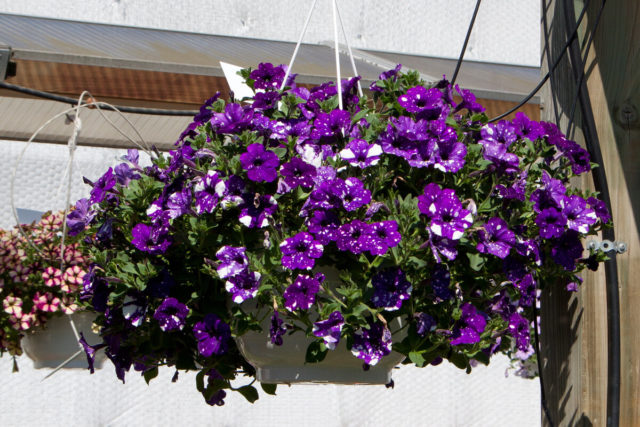
Hybrid Starry Sky is often grown on terraces and verandas in flowerpots
In addition, many are attracted by the fact that the crop can be planted in pots on terraces and balconies, and in open ground on the site.
Possible disadvantages include a tendency to a number of diseases, especially powdery mildew and gray rot, as well as the inability to propagate petunia using seeds. The culture requires vegetative division.
Reproduction of petunia Starry sky
Since Starry Sky petunia propagates exclusively by the vegetative method, it is advisable to prepare the cuttings in the correct way. They should be about 10 cm long. They need to be placed in water and after the roots appear, after 10-14 days, the cuttings can be transplanted into a container with a peat substrate. During this period, the plant is fed through the leaf blades, since the root system is not yet fully formed.
It is recommended to spray the cuttings twice a day with warm water and feed them once with Kornevin at the rate of 20 g per 10 liters of water. After another 2 weeks, the root system should be fully formed. The resulting small bush of petunia Starry Sky can be transplanted into a pot with a volume of up to 2.5-3 liters.
Growing Petunia Starry Sky
Before you start transplanting petunias from the Starry Sky series, you need to familiarize yourself with important information about the soil necessary for it. It should consist of the following components:
- sand – 1 part;
- peat – 2 parts;
- humus - 2 parts;
- turf and leaf soil - 2 parts each.
With this soil composition, petunia will actively grow, develop and bloom luxuriantly. It is advisable to sift and moisten the substrate immediately before planting, since the soil should be light.
Replant petunia in cloudy weather or in the late afternoon.The young plant should be placed in a prepared hole along with a lump of earth, so the crop adapts faster to open ground conditions. The holes should be made at intervals of at least 25 cm, and each hole should be 10*10 cm in size. It is advisable to mulch the soil so that rooting goes faster.
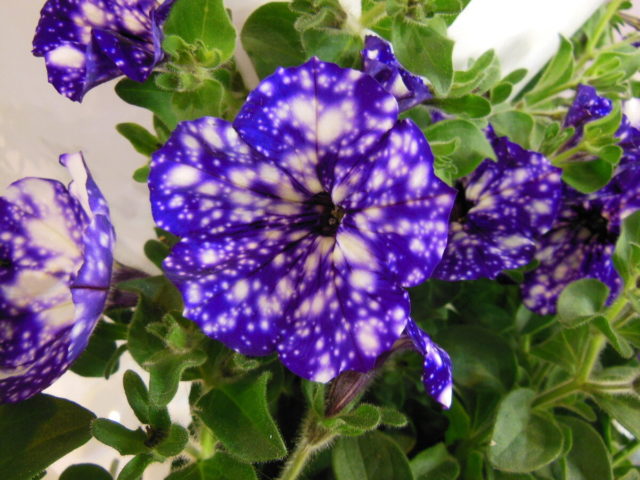
Hybrid Starry Sky prefers diffused sunlight
When choosing a location, you need to keep in mind that the hybrid petunia Night Sky prefers partial shade, that is, the sunlight should be bright, but direct exposure to rays is excluded. For proper development of the plant and long-term abundant flowering, the crop requires at least 11-12 hours of daylight. If it is not enough, then you need to take care of an additional light source.
Flower care
Growing Starry Sky petunia correctly means following certain standards. These include proper watering and fertilizing regimes, preventive spraying and decorative pruning of the bush. In addition, it is important to monitor the temperature.
Fertilizer application should be combined with watering. The first feeding is carried out exclusively with phosphorus compounds. This is necessary to strengthen the root system. After 2 weeks, complex fertilizers or nitrogen fertilizers will be required. During the ripening period of the buds, you can add potassium fertilizers. During flowering, water-soluble fertilizers will be required.
To form a beautiful bush you need pruning. If the branches grow long, this will gradually lead to their thinning, and the flowers will begin to become smaller. In addition, the petals lose their unique brightness.
Watering petunias begins from the moment the plant is transplanted. You need to water at the root as soon as the soil dries out, approximately once every 3-4 days.During the procedure, you need to ensure that moisture does not get on the flower or bud.
As for the temperature regime, petunia can withstand up to 35 °C heat; at night the readings should not fall below 10 °C. For petunia Starry Sky, a difference in day and night temperatures of 10-15 °C is important. This has a positive effect on the formation of white specks on a purple background.
Pests and diseases
Petunia (Petunia Night Sky) is hard to withstand attacks from aphids, spider mites and thrips. To prevent exposure to parasites, it is necessary to provide the plant with proper care, namely, the soil should not be allowed to become excessively moist and the temperature regime should not be disturbed. It is important to inspect your petunias regularly to prevent their activity early on.
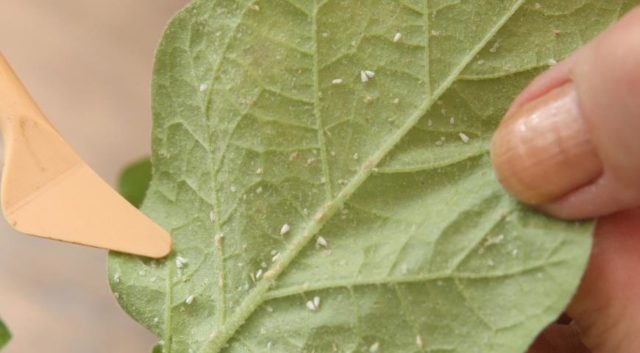
Timely inspection is important for crops so as not to miss the development of disease and pest attacks.
Spider mites can be seen on petunia buds. In addition to small insects, dots or white plaque with a thin sticky web are visible. As soon as the first signs of parasites are noticed, you need to remove the affected parts of the plant, and then treat the crop with special preparations.
When aphids appear, you can try to influence them with a solution of tobacco and laundry soap. If the stage of the disease is quite dangerous, then more serious drugs must be used. Thrips appear on both sides of the leaf blade, causing the leaf to quickly dry out and fall off. The most effective drug is Aktara, Confidor.
As for fungal diseases, it is also better to start treating them in the early stages. They appear on the leaves in the form of plaque, stickiness, and spots. Before treating with drugs, you need to trim the affected areas and then spray with Ordan or Trichodermil.
Application in landscape design
Ampel varieties of petunias, which include the Starry Sky variety, develop well in flower beds, in flowerpots and in vertical planting. Before planting, you should consider different options, including unusual raised, round shapes, as well as a gravel garden, a flower ball.
Petunia looks most advantageous with cereals, hosta, all bulbous crops, and marigolds. Experts recommend combining compositions with long-flowering plants that are resistant to hot weather.
Conclusion
Petunia Starry Sky is a flower of amazing beauty. It is strikingly different from other varieties in appearance. Its main color is dark purple and against this background white patches are clearly visible. This gives the impression of a night sky with bright stars. In addition, gardeners fell in love with the variety because of its ease of care and rapid development.
Reviews with photos about the petunia variety Starry Sky
